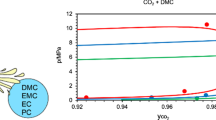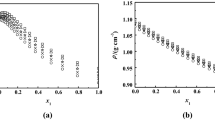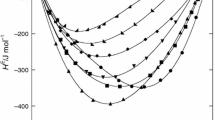Abstract
The fugacity coefficients of hydrogen in binary mixtures with carbon dioxide were measured using a physical equilibrium technique. This technique involves the use of an experimental chamber which is divided into two regions by a semipermeable membrane. Hydrogen can penetrate and pass through the membrane, while the other component (in this case carbon dioxide) cannot. At equilibrium, pure hydrogen will permeate into one “compartment” of the chamber, while the binary mixture occupies the other compartment. Thus, the pressure of pure hydrogen on one side of the membrane approaches the partial pressure of hydrogen in the mixture on the other side of the membrane. This allows the direct measurement of the hydrogen component fugacity at a given mixture mole fraction. In this study, results are reported for measurements made on the hydrogen+carbon dioxide binary at 80°C (353 K), 130°C (403 K), 160°C (433 K), and 190°C (463 K), each at a total mixture pressure of 3.45 MPa. The experimental results are compared with predictions from the Redlich-Kwong, Peng-Robinson, and extended corresponding-states models.
Similar content being viewed by others
References
S. I. Sandler, Chemical and Engineering Thermodynamics (John Wiley and Sons, New York, 1977).
B. G. Kyle, Chemical and Process Thermodynamics (Prentice Hall, Englewood Cliffs, N.J., 1984).
J. M. Prausnitz, Molecular Thermodynamics of Fluid Phase Equilibria (Prentice Hall, Englewood Cliffs, N.J., 1969).
H. Y. Cheh, Proceedings of the 6th Symposium of Thermophysical Properties, P. E. Liley, ed. (Am. Soc. Mech. Eng., New York, 1973), p. 256.
T. J. Bruno, J. Res. Natl. Bur. Stds. 90 (2):127 (1985).
T. J. Bruno, G. L. Hume, and J. F. Ely, Int. J. Thermophys. 7:1033 (1986).
D. P. Smith, Hydrogen in Metals (University of Chicago Press, Chicago, 1948).
E. M. Wise, Palladium (Academic Press, New York, 1968).
B. Mason, Principles of Geochemistry, 3rd ed. (John Wiley and Sons, New York, 1958).
T. J. Bruno and G. L. Hume, J. Res. Natl. Bur. Stds. 90 (3):225 (1985).
T. J. Bruno, J. Chromatogr. Sci. 23(7):325 (1985).
H. M. McNair and E. J. Bonnelli, Basic Gas Chromatography (Varian Aerograph, 1969).
E. Heftmann, Chromatography, A Laboratory Handbook of Chromatographic and Electrophoretic Methods (Van Nostrand Reinhold, New York, 1975).
F. Antezana and H. Y. Cheh, Ind. Eng. Chem. Fund. 14:224 (1975).
F. Antezana and H. Y. Cheh, Ind. Eng. Chem. Fund. 15:95 (1976).
Author information
Authors and Affiliations
Rights and permissions
About this article
Cite this article
Bruno, T.J., Hume, G.L. Hydrogen component fugacities in binary mixtures with carbon dioxide. Int J Thermophys 7, 1053–1063 (1986). https://doi.org/10.1007/BF00502377
Received:
Issue Date:
DOI: https://doi.org/10.1007/BF00502377




